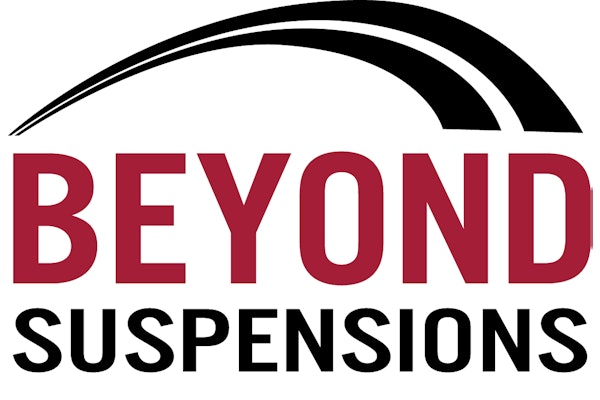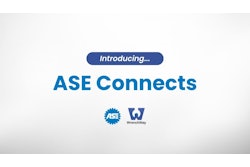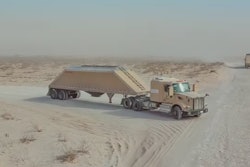Carrier-to-Housing Joint Repair Procedure
Use the following procedure to repair the carrier-to-housing joint on all Meritor 120, 145, 160, 180 and 380 series axles:
- Park the vehicle on a level surface, set the parking brake and block the wheels.
- Remove the carrier from the housing.
- Remove all debris from inside the housing.
- Use a rotary tool with a scour pad to clean all silicone residue from the housing and carrier faces, as shown in Figure 1. Surfaces must be clean, dry and free of contaminants. Surfaces must not be oily to touch, refer to Figure 2.
- Remove metal filings from the magnets inside the housing
- Use solvent to clean the inside of the housing.
- Use Loctite ODC Free cleaner or brake cleaner to clean the housing and carrier faces.
- Dry the housing and carrier faces.
Caution: New capscrew kits have blue Dri-Loc STS threadlocker applied to the capscrews. Do not remove it. - If you reuse the carrier-to-housing capscrews, use a rotary wire brush to remove any threadlocker material and clean the capscrew threads. Use a clean cloth to wipe the threads.
- Use a tap to clean the internal threads in the housing.
- Apply a 0.25-inch bead of Loctite 5699 silicone gasket material to the housing face. Do not use ThreeBond 1216E silicone products (see Figure 3).
- Install two long studs into the carrier to guide the carrier into the housing.
- Immediately install the carrier into the housing to permit the silicone gasket material to compress evenly between the faces.
- Apply a 0.125-inch bead of Loctite 242 threadlocker around the reused capscrew threads approximately 0.25-inch from the end. Apply a 0.125-inch bead of Loctite 242 threadlocker across the lengths of the threads. Do not apply Loctite 242 threadlocker to new capscrews with the blue pre-applied threadlocker patch (see Figure 4).
- Install the capscrews. Use a crossing pattern to tighten the capscrews evenly. The capscrews must be tightened within 10 minutes of initial application of Loctite 242 threadlocker. Tighten 1/2-inch capscrews to 140 lb.-ft. Tighten 5/8-inch capscrews ti 225 lb.-ft.
- Wait a minimum of 60 minutes before filling the assembly with lubricant.
Reman Fuel Injectors Improved
There have been some issues with Caterpillar mechanical unit injectors on models: 3114 ATAAC NA D1 (S/N: 5YL1-Up); 3114 (S/N: 9LL1-Up); 3116 ATTAC D1 (S/N: 2BK1-Up; 7SF1-Up); 3116 (S/N CSM1-Up; 2FR1-Up; 7HS1-Up; 9Gk1-Up; 7HJ1-Up and 9CJ1-Up); 3116 ATAAC (S/N: 7JL1-Up); and 3116 T (S/N: 9LN1-Up and 9YN1-Up).
The remanufactured mechanical unit injectors are now shipped with the rack in the fuel “off” position in order to eliminate the need to move the fuel rack before installation into the cylinder head.
The fuel rack on the mechanical unit injectors should not be moved without compressing the tappet spring.
The issue is the dragging of the fuel rack and was caused by the process of remanufacturing the cones for the fuel injectors. The remanufactured cones were causing the rack to drag. The cones now are remanufactured in order to eliminate the fuel rack from dragging.
The change in the process of remanufacturing the cones for the injectors has caused the cones to have some discoloration. The change in the appearance of the remanufactured cones is normal. The discoloration will not affect the performance of the fuel injectors.
Safety Recalls
The National Highway Traffic Safety Administration (NHTSA) has issued the following recalls:
- Rear axle spring leaves on 277 model year 2008 Freightliner or Dodge Sprinter 2500 trucks were produced with an incorrect raw material. As a result, the leaves are thicker than the serial components. The rear axle springs may fail earlier than designed, increasing the risk of a crash. Defective rear axle leaves springs need to be replaced.
- The left drive shafts on the rear axle of 79 model year Freightliner or Dodge Sprinter 3500 trucks which were labeled with the charge indicator “S” may contain cracks at the radius between the shaft and the flange. These cracks may cause the drive shaft to break, increasing the risk of a crash. Defective drive shafts must be replaced.
- Almost 25,000 model year 2003 through 2008 IC school and commercial bus models BE, CE, HC and RE and 2002 through 2008 International 3200 and 3300 model buses manufactured between September 21, 2001, and December 14, 2007, equipped with International VY 365 engines may exhibit engine hard start, no start or stall conditions. This could be the result of damaged terminals in the fuse holder connector of the injector drive module clean battery power circuits. The terminals may have been damaged during electrical continuity testing in the manufacturing process. These conditions could result in a crash. The IDM fuse holder needs to be replaced.
- The hose assembly that supplies high pressure oil to the engine’s cylinder head on 1,765 model year 1998 through 2003 International RE school and commercial buses may deteriorate and allow oil to leak or mist in the engine compartment. Leaking or misting oil in the engine compartment may ignite, resulting in a fire. The hose assembly needs to be replaced.
- Un-fused power cables were tie wrapped to a wire braid engine fuel return hose on 3,402 model year 1996 to 2001 Thomas Built MVP ER school buses manufactured from June 8, 1995, through February 16, 2001. Over time, these cables may chafe, wearing through the wire loom and eventually through the cable insulation and fuel line covering in an area not easily detectable during normal maintenance without removing the tie wraps and opening the wire loom. Un-fused and un-switched power cables which wear through and contact the fuel line wire braid may short circuit. In the event of a short circuit, a vehicle fire can occur. The cables need to be inspected and replaced as needed.
DPF Outlet Pipe Heat Shield
The sleeper rail may contact the outlet pipe heat shield during up and down movement of the cab on certain Mack CXU and CHU sleeper model chassis equipped with a dual exhaust and Mack-cap diesel particulate filter, as shown in Figure 5.
If you encounter this condition, the existing heat shield must be removed and a new heat shield (Part No. 13ME576M) installed on the vertical section of the exhaust outlet pipe.
Use the following procedure:
- Remove the four bolts that secure the heat shield to the clamps, and then remove and discard the shield.
- Relocate the two clamps onto the vertical section of the outlet pipe.
- Using the four existing bolts, install the new heat shield (Part No. 13ME576M). Install the heat shield with the bend in the shield facing up, and position the shield toward the marker/turn signal lamp, as shown in Figure 6.
- Tighten the shield clamp bolts to 45 lb.-ft.
Bolt-On Housing Cover Fastener Installation
Use the following procedure to install the bolt-on housing cover fasteners on Dana series D190/S190/D590 drive axles:
- Before installing new fastener hardware or the cover assembly, the axle housing should be visually inspected for cracks, nicks or burrs on all machined surfaces. Clean the threaded bolt holes in the axle housing, removing any paint, old sealant or oil from the housing and cover mounting surfaces. Studs need to be replaced only if the stud came out with the nut at the time of disassembly.
- Apply a 1⁄8-inch bead of RTV sealant to the housing surface. It is important to apply the sealant around (make a loop) all of the threaded bolt holes. Reinstall the rear cover assembly.
- Install new fasteners supplied in the kit.
- Torque the capscrews or nuts to the correct specifications. If you are installing studs, be sure to install them to the proper specification.
- Install the carrier-to-housing studs into the housing until the exposed height is 1.5 inches above the housing ring.
Dana does not recommend mixing old and new carrier fasteners on the same carrier. If you are reusing old fasteners, use Loctite 277 or 271 (which is red in color) on the threads of the old fastener and torque to the correct specification. Final torque values of hardware fasteners must be measured using a calibrated torque wrench.
New Fuel Pressure Regulator
A new fuel pressure regulator now is used on Caterpillar C7 (S/N: C7S1-Up) and C9 (S/N: C9S1-Up) engines. The new regulator eliminates the need for an O-ring. This is said to improve the reliability of the regulator.
Confirm that the regulator on the engine has not been updated previously. Do not replace the present regulator with the new 314-9611 regulator unless the diagnostic trouble code 651-7 through 656-7 (engine injector cylinder #01 through #06 not responding properly) is present in the ECM. Submit only one warranty claim for the replacement of the regulator and lines. Use the injector as the part that is causing the diagnostic.







